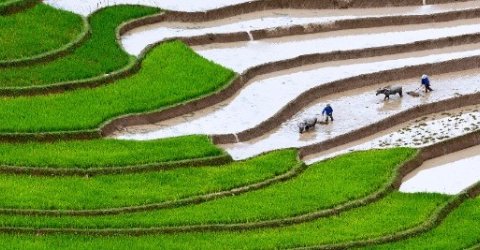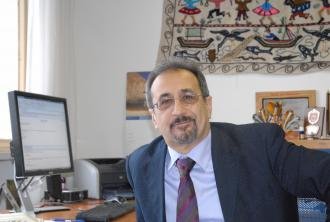
Culture, Agriculture and Innovation for Sustainable Development
The memory of agriculture and associated civilisations is carried by landscapes, seeds, plants, animals and by farmers' knowledge and technologies, but also by oral traditions, languages, arts, rituals, culinary traditions, and unique forms of social organisation. Together, these elements combine to form living agricultural systems and their associated cultures. In many countries, unique agricultural systems and landscapes have been created and maintained by generations of farmers, herders and fisher-folk, using locally adapted, distinctive and often ingenious combinations of management practices and techniques.
Traditional agriculture is often considered “backward”, doomed to be phased out in the course of modernisation. Numerous Agricultural Heritage Systems around the world have, however, proven their robustness and resilience, and have stood the test of time. They offer solutions for present and future generations, and for environmental sustainability. They represent a wealth of biological resources, knowledge systems and management practices for producing healthy products that can help to ensure food security and quality of life for humanity and to cope with the challenges of today and tomorrow.
Building on generations of accumulated knowledge and experience, these ingenious agri-“cultural” systems reflect the evolution of humanity and ways of living in harmony with nature. They have resulted not only in outstanding aesthetic beauty, maintenance of globally significant agricultural biodiversity, resilient ecosystems and valuable cultural heritage but, above all, they have supported the sustained provision of a range of goods and services for the poorest and most remote communities.
Traditional agriculture associated with wetlands and water bodies is among the most important heritage of mankind. Wetlands have been used for agriculture for millennia, especially riverine wetlands in floodplains, where soils are fertile and water is plentiful. Indeed, wetlands have nurtured the development of many important cultures around the world. With the emergence of modern agriculture, however, wetlands have suffered widespread drainage to expand productive land and increase efficiency.
According to the United States National Research Council, 47 million hectares of wetlands in the USA were drained over the past two centuries, and 85% of inland waters there are now artificially controlled. This has created new farmland, but sometimes at the expense of habitats for biodiversity and ecosystem services such as nutrients cycling, flood protection, and important cultural values.
In Europe, river valleys used to contain many water meadows producing a late winter or early spring crop of grass. More importantly, when the river did flood, water was stored on the meadows, and did not harm housing or other vulnerable areas. But in the drive towards intensification of food production, most of these meadows have been converted to arable fields. At the same time, rivers have been tamed through channelling, field sizes have increased, and hedgerows have been removed. Now, when it rains, the consequence is increased flooding of vulnerable areas.
Japan provides another example of the wider value of agricultural wetlands, in this case irrigated paddy rice fields. Japan’s very high rainfall, concentrated into a few months in a mountainous landscape with short horizontal distances to the sea, poses severe flood risks. Paddy rice farming, however, provides an important sink for this water. There are more than two million hectares of paddy rice in Japan, and every hectare holds about a thousand tonnes of water. In the Koshigaya City basin, 25 km north of Tokyo, paddy fields close to the city have been steadily converted to residential uses over the past half century.
In China, the conversion of 500,000 hectares of wetlands to for crop production over the past 60 years has resulted in the loss of a flood-water storage capacity of some 50 billion cubic metres.
The agricultural heritage systems associated with wetlands deserve priority recognition and safeguarding, because of their contribution to local livelihoods and food security, indigenous knowledge and conservation of biodiversity as well as other ecosystem services, particularly in an era of climate change. Not only do these agricultural heritage systems embody the accumulated wisdom of the past, they are also the building blocks of our future in a rapidly changing world.
Globally Important Agricultural Heritage Systems (GIAHS) such as the Hanni Rice Terraces in China, the Floating Gardens of Bangladesh and the We-We Lake system in Sri Lanka, should receive priority attention in view of increasing threats to their existence. The GIAHS designation does not merely serve to identify interesting systems, but supports a sense of pride in the communities that have nurtured them. This in turn can be the key to some vital innovations that have their roots in the past but on which we may depend in the future.

Dr. Parviz Koohafkhan (Founder and President of the World Agricultural Heritage Foundation)
Dr. Koohafkan conceptualized and launched on behalf of FAO, the UN Partnership Initiative on “Conservation and Adaptive Management of Globally Important Agricultural Heritage Systems (GIAHS)” during the World Summit on Sustainable Development in Johannesburg South Africa (WSSD, 2002) and promoted the recognition by FAO, and dynamic conservation of Globally Important Agricultural Heritage Systems (GIAHS) in many countries around the world. He is currently Senior Advisor in Food and Agriculture Organization of the United Nations and Honorary Senior Research Fellow at Bioversity International (formerly IPGRI) in Rome, Italy, and the Research Institute for Humanity and Nature (RIHN) in Kyoto, Japan.
He has an Engineering degree in Agronomy and Natural Resources Management from University of Teheran, Iran and a Masters degree and Ph.D. in Applied Ecology from the University of Sciences and Techniques of Montpellier, France. His fields of specialization are sustainable agriculture and rural development; integrated natural resources management; biodiversity and genetic resources sustainable livelihoods and climate change adaptation and mitigation.
He held several senior positions in the Food and Agriculture Organization of United Nations (FAO) including the positions of Director of Land and Water Division, Director of the Climate Change and Bio-energy Division, and the Director of Rural Development Division in the Sustainable Development Department and was the FAO focal point for Rio Summit from 1992 to 2012.
With Persian as his mother tongue, he is fluent in English, Spanish, French and Italian and is the author of several books and publications on biodiversity, agro-ecology, natural resources management, climate change and sustainable development.